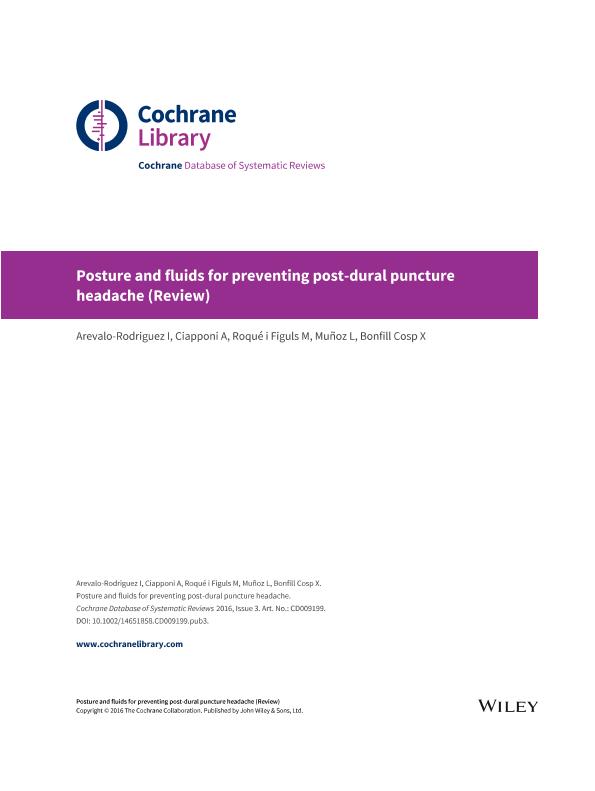Mostrar el registro sencillo del ítem
dc.contributor.author
Arevalo Rodriguez, Ingrid
dc.contributor.author
Ciapponi, Agustín

dc.contributor.author
Roqué i Figuls, Marta
dc.contributor.author
Muñoz, Luis
dc.contributor.author
Bonfill Cosp, Xavier
dc.date.available
2018-07-31T19:57:14Z
dc.date.issued
2016-03
dc.identifier.citation
Arevalo Rodriguez, Ingrid; Ciapponi, Agustín; Roqué i Figuls, Marta; Muñoz, Luis; Bonfill Cosp, Xavier; Posture and fluids for preventing post-dural puncture headache; John Wiley & Sons Ltd; Cochrane Database of Systematic Reviews; 2016; 3; 3-2016; 1-65
dc.identifier.issn
1469-493X
dc.identifier.uri
http://hdl.handle.net/11336/53659
dc.description.abstract
Background: Post-dural puncture headache (PDPH) is a common complication of lumbar punctures. Several theories have identified the leakage of cerebrospinal fluid (CSF) through the hole in the dura as a cause of this side effect. It is therefore necessary to take preventive measures to avoid this complication. Prolonged bed rest has been used to treat PDPH once it has started, but it is unknown whether prolonged bed rest can also be used to prevent it. Similarly, the value of administering fluids additional to those of normal dietary intake to restore the loss of CSF produced by the puncture is unknown. This review is an update of a previously published review in the Cochrane Database of Systematic Reviews (Issue 7, 2013) on "Posture and fluids for preventing post-dural puncture headache". Objectives: To assess whether prolonged bed rest combined with different body and head positions, as well as administration of supplementary fluids after lumbar puncture, prevent the onset of PDPH in people undergoing lumbar puncture for diagnostic or therapeutic purposes. Search methods: We searched the Cochrane Central Register of Controlled Trials (CENTRAL), MEDLINE, EMBASE, and LILACS, as well as trial registries up to February 2015. Selection criteria: We identified randomized controlled trials that compared the effects of bed rest versus immediate mobilization, head-down tilt versus horizontal position, prone versus supine positions during bed rest, and administration of supplementary fluids versus no/less supplementation, as prevention measures for PDPH in people who have undergone lumbar puncture. Data collection and analysis: Two review authors independently assessed the studies for eligibility through the web-based software EROS (Early Review Organizing Software). Two different review authors independently assessed risk of bias using the criteria outlined in the Cochrane Handbook for Systematic Reviews of Interventions. We resolved any disagreements by consensus. We extracted data on cases of PDPH, severe PDPH, and any headache after lumbar puncture and performed intention-to-treat analyses and sensitivity analyses by risk of bias. We assessed the evidence using GRADE (Grading of Recommendations Assessment, Development and Evaluation) and created a 'Summary of findings' table. Main results: We included 24 trials with 2996 participants in this updated review. The number of participants in each trial varied from 39 to 382. Most of the included studies compared bed rest versus immediate mobilization, and only two assessed the effects of supplementary fluids versus no supplementation. We judged the overall risk of bias of the included studies as low to unclear. The overall quality of evidence was low to moderate, downgraded because of the risk of bias assessment in most cases. The primary outcome in our review was the presence of PDPH. There was low quality evidence for an absence of benefits associated with bed rest compared with immediate mobilization on the incidence of severe PDPH (risk ratio (RR) 0.98; 95% confidence interval (CI) 0.68 to 1.41; participants = 1568; studies = 9) and moderate quality evidence on the incidence of any headache after lumbar puncture (RR 1.16; 95% CI 1.02 to 1.32; participants = 2477; studies = 18). Furthermore, bed rest probably increased PDPH (RR 1.24; 95% CI 1.04 to 1.48; participants = 1519; studies = 12) compared with immediate mobilization. An analysis restricted to the most methodologically rigorous trials (i.e. those with low risk of bias in allocation method, missing data and blinding of outcome assessment) gave similar results. There was low quality evidence for an absence of benefits associated with fluid supplementation on the incidence of severe PDPH (RR 0.67; 95% CI 0.26 to 1.73; participants = 100; studies = 1) and PDPH (RR 1; 95% CI 0.59 to 1.69; participants = 100; studies = 1), and moderate quality evidence on the incidence of any headache after lumbar puncture (RR 0.94; 95% CI 0.66 to 1.34; participants = 200; studies = 2). We did not expect other adverse events and did not assess them in this review. Authors' conclusions: Since the previous version of this review, we found one new study for inclusion, but the conclusion remains unchanged. We considered the quality of the evidence for most of the outcomes assessed in this review to be low to moderate. As identified studies had shortcomings on aspects related to randomization and blinding of outcome assessment, we therefore downgraded the quality of the evidence. In general, there was no evidence suggesting that routine bed rest after dural puncture is beneficial for the prevention of PDPH onset. The role of fluid supplementation in the prevention of PDPH remains unclear.
dc.format
application/pdf
dc.language.iso
eng
dc.publisher
John Wiley & Sons Ltd

dc.rights
info:eu-repo/semantics/openAccess
dc.rights.uri
https://creativecommons.org/licenses/by-nc-sa/2.5/ar/
dc.subject
Posture And Fluids for Preventing Post-Dural Puncture Headache
dc.subject.classification
Salud Ocupacional

dc.subject.classification
Ciencias de la Salud

dc.subject.classification
CIENCIAS MÉDICAS Y DE LA SALUD

dc.title
Posture and fluids for preventing post-dural puncture headache
dc.type
info:eu-repo/semantics/article
dc.type
info:ar-repo/semantics/artículo
dc.type
info:eu-repo/semantics/publishedVersion
dc.date.updated
2018-07-25T13:57:08Z
dc.journal.volume
2016
dc.journal.number
3
dc.journal.pagination
1-65
dc.journal.pais
Reino Unido

dc.journal.ciudad
LOndres
dc.description.fil
Fil: Arevalo Rodriguez, Ingrid. Hospital de San José; Colombia
dc.description.fil
Fil: Ciapponi, Agustín. Consejo Nacional de Investigaciones Científicas y Técnicas; Argentina. Instituto de Efectividad Clínica y Sanitaria; Argentina
dc.description.fil
Fil: Roqué i Figuls, Marta. CIBER Epidemiología y Salud Pública ; España. Biomedical Research Institute Sant Pau; España
dc.description.fil
Fil: Muñoz, Luis. Hospital de San José; Colombia
dc.description.fil
Fil: Bonfill Cosp, Xavier. CIBER Epidemiología y Salud Pública ; España. Biomedical Research Institute Sant Pau; España
dc.journal.title
Cochrane Database of Systematic Reviews

dc.relation.alternativeid
info:eu-repo/semantics/altIdentifier/doi/https://dx.doi.org/10.1002/14651858.CD009199.pub3
dc.relation.alternativeid
info:eu-repo/semantics/altIdentifier/url/http://cochranelibrary-wiley.com/doi/10.1002/14651858.CD009199.pub3/abstract;jsessionid=84C6B277D8D327FE883782577F198572.f04t01
Archivos asociados
